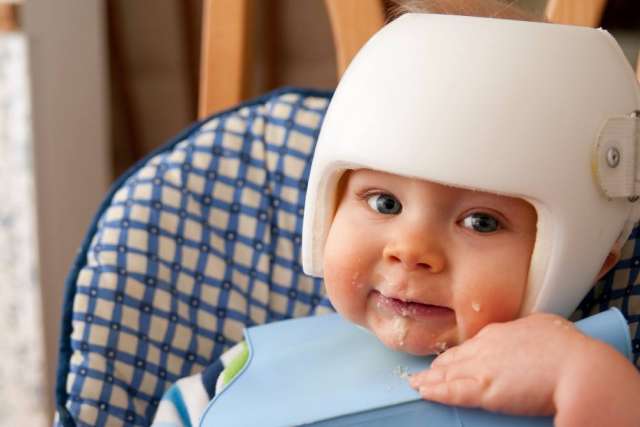Babies come in all different shapes and sizes. But if your infant’s head shape is giving you cause for concern, it may be plagiocephaly — a condition where your baby has a flat spot or misshapen head.
In rare cases, plagiocephaly is caused by a congenital condition present at birth called craniosynostosis. More often, an infant develops positional plagiocephaly because of the way their head is positioned during pregnancy, birth or infancy.
The good news is that this common type of plagiocephaly, also called flat head syndrome, generally does not interfere with your child’s development. And it’s highly treatable.
Here are five facts about positional plagiocephaly:
1. Flat head syndrome can develop for many reasons
Babies have soft skull bones for months after birth, and for good reason — soft, pliable bones allow a baby’s brain to grow and their head to make it safely through the birth canal. But during pregnancy, birth and infancy, those soft bones can change shape or give the head a misshapen appearance.
Causes of positional plagiocephaly include:
- Birth complications, such as a difficult labor, the baby’s position in the birth canal or the use of forceps or vacuum during birth
- Multiple birth (such as twins or triplets),which may account for cramping or unusual positioning in the womb
- Preferred head position while sleeping or sitting
- Premature birth, which may require a longer hospitalization while bones are much softer than that of full-term babies
- Torticollis, in which tight or shortened neck muscles make it difficult for babies to reposition their heads
2. Positional plagiocephaly is common
Most infants sleep on their backs — the for infants. But all that time spent in the same position can sometimes lead to a flattened area on the head. Approximately one out of four babies who sleep on their back will develop flat head syndrome. And when babies lay in the same position for extended periods outside of the crib, it increases the risk.
According to the American Academy of Family Physicians, about 50% of children will develop positional plagiocephaly. For most babies, it occurs during the first four to 12 weeks of life. But 20% of babies are born with a misshapen head due to circumstances in the womb or birth canal.
3. You can decrease your infant’s risk of positional plagiocephaly
The National Association for Plagiocephaly recommends taking proactive measures to help your baby’s head develop evenly:
Incorporate repositioning techniques
Changing the way your baby’s head turns during various activities can help develop a full range of motion in their neck. Consider:
- Alternating the direction your baby lays in the crib or on the diaper changing table
- Carrying the baby on both sides of your body instead of always using the same side
- Encouraging your baby to suck the opposite thumb if they prefer one — babies naturally turn their heads toward the thumb they are sucking
- Limiting time spent in car seats, baby swing and bouncy seats
- Placing toys on both sides of the crib, car seat and play mat to encourage head movement
Provide adequate tummy time
Babies don’t need to be a certain age to start spending time on their tummies. You can begin by placing your infant on their belly across your lap for just a few minutes at a time, a couple of times a day.
Gradually increase to placing your baby onto a mat or blanket on the floor. Add a little each session and work up to 20 minutes of tummy time a day (can be multiple sessions) by the time your little one is 3 to 4 months old.
4. Early diagnosis and treatment of plagiocephaly are important
There are no known medical complications associated with flat head syndrome. But treating the cosmetic effects is easier when the bones are still soft and pliable.
Your pediatrician will measure and assess your baby’s head at routine checkups. But you can also monitor your baby’s head shape at home. Signs and symptoms of flat head syndrome include:
- Asymmetrical features, such as one cheek looking fuller than the other or one ear being pushed forward
- Flattened area on the back, side or front of your baby’s head
- Head that appears misshaped or slanted
- Lack of hair in one spot
There are no tests needed to diagnose positional plagiocephaly. If your pediatrician suspects a more serious condition, such as congenital plagiocephaly, your child may need additional tests such as a skull X-ray or CT scan.
5. Cranial helmet therapy isn’t the only treatment option for flat head syndrome
In most cases, a flattened head does not affect brain growth or mental development. The condition typically improves — though may not resolve completely — once your child spends more time sitting and standing.
There are several ways to treat flat head syndrome:
- Corrective headband therapy uses applied pressure to encourage the head to grow only where needed.
- Cranial helmet therapy involves your baby wearing a fitted helmet for 23 hours a day (leaving an hour daily for bathing and cleaning) for an average of three months. This therapy may help reform the skull but can be expensive, possibly costing $4,000 or more.
- Physical therapy helps practice positional exercises and stretches the neck muscles, especially in cases where torticollis is present.
- Sleep position changes are modifications prescribed by your pediatrician to promote proper skull formation while sleeping on the back.
Always consult with your pediatrician before trying any products or techniques claiming to prevent or treat plagiocephaly.
If you are concerned that your infant may have flat head syndrome, reach out to your child’s pediatrician.



